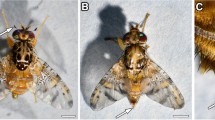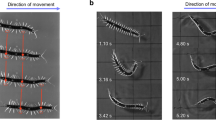Abstract
MOST higher invertebrates and all vertebrates are metamerically segmented and their evolution has depended on the progressive functional specialisation of serially repeated, originally similar segments. In structurally similar body segments, serially homologous neurones have been shown to have remained largely unchanged1–4. Is this also the case for serially homologous neurones in segments which show important morphological and functional differences? We report here that we have identified motoneurones innervating muscles in the first two pairs of legs of the locust Schistocerca gregaria, Forskal (=S. americana, Dirsch). These legs are similar and represent the primitive unspecialised form, functioning especially in posture and walking. The hind legs are greatly enlarged and specialised for jumping, and motoneurones innervating muscles in these legs have been identified5. In walking, the legs in a segment move alternatively, whereas in jumping, both hind legs act almost synchronously6. We have found that serially homologous motoneurones have evolved new functional properties for jumping while retaining their primeval morphologies.
This is a preview of subscription content, access via your institution
Access options
Subscribe to this journal
Receive 51 print issues and online access
$199.00 per year
only $3.90 per issue
Buy this article
- Purchase on Springer Link
- Instant access to full article PDF
Prices may be subject to local taxes which are calculated during checkout
Similar content being viewed by others
References
Mittenthal, J. E. & Wine, J. J. J. comp. Neurol. 177, 311–334 (1978).
Burrows, M. J. exp. Biol. 62, 189–219 (1975).
Simmons, P. J. J. exp. Biol. 71, 123–140 (1977).
Yua, K.-W. J. Physiol., Lond. 263, 489–512 (1976).
Burrows, M. & Hoyle, G. J. Neurobiol. 4, 167–186 (1973).
Heitler, W. J. & Burrows, M. J. exp. Biol. 66, 203–219 (1977).
Hoyle, G. & Burrows, M. J. Neurobiol. 4, 3–41 (1973).
Wilson, J. A. thesis, Univ. Oregon (1977).
Hoyle, G. in Recent Advances in Invertebrate Physiology (ed. Scheer, B. T.)(University of Oregon Press, Eugene, 1957).
Bate, C. M. J. Embryol. exp. Morph. 35, 107–123 (1976).
Burrows, M. & Horridge, G. A. Phil. Trans. R. Soc. B 269, 49–94 (1974).
Bennett-Clark, H. C. J. exp. Biol. 63, 53–83 (1975).
Heitler, W. J. J. exp. Biol. 67, 29–36 (1977).
Hoyle, G. J. exp. Biol. 73, 205–233 (1978).
Author information
Authors and Affiliations
Rights and permissions
About this article
Cite this article
WILSON, J., HOYLE, G. Serially homologous neurones as concomitants of functional specialisation. Nature 274, 377–379 (1978). https://doi.org/10.1038/274377a0
Received:
Accepted:
Issue Date:
DOI: https://doi.org/10.1038/274377a0
This article is cited by
-
Homonomies within the ventral muscle system and the associated motoneurons in the locust, Schistocerca gregaria (Insecta, Caelifera)
Zoomorphology (1995)
-
Motor supply of the dorsal longitudinal muscles, I: homonomy and ontogeny of the motoneurones in locusts (Insecta, Caelifera)
Zoomorphology (1995)
-
Crustacean cardioactive peptide-immunoreactive neurons in the ventral nerve cord and the brain of the meal beetle Tenebrio molitor during postembryonic development
Cell and Tissue Research (1991)
-
Constancies in the neuronal architecture of the suboesophageal ganglion at metamorphosis in the beetleTenebrio molitor L.
Cell and Tissue Research (1991)
-
The innervation of the pyloric region of the crab,Cancer borealis: Homologous muscles in decapod species are differently innervated
Journal of Comparative Physiology A (1986)
Comments
By submitting a comment you agree to abide by our Terms and Community Guidelines. If you find something abusive or that does not comply with our terms or guidelines please flag it as inappropriate.



